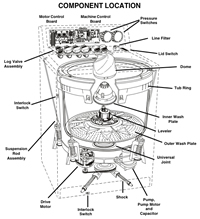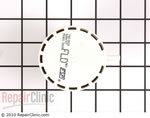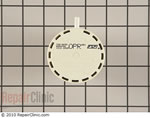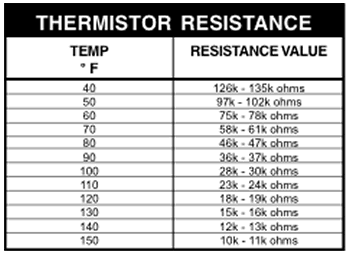
Calypso Washing Machine Parts
Other Calypso Washing Machine Links:
CALYPSO UNIVERSAL JOINT
During Nutation, the Wash Plate is tipped at a 35 degree
angle and must be free to undulate to move the clothing
properly. The Wash Plate is attached to a Universal Joint
that allows the Plate that freedom of movement.
The Universal Joint is attached to the basket drive block by
a spanner nut and is sealed top and bottom by a boot and
various seals to keep water from damaging its pivoting parts.
The boot is attached to the bottom of the U-Joint and prevents
water from getting to the U-Joint from underneath. Attached
to the basket drive hub is an O-ring that forms a
seal between the U-Joint boot and the basket drive hub.
The top of the U-Joint is sealed by six, (6), grommets and a
gasket that is attached to the underside of the inner wash
plate. The six grommets, wash plate gasket and/or O-ring
MUST be replaced whenever their sealing surface(s) have been disturbed. The Seal Kit is Part #285842.
The leveler tilts the nutate or outer wash plate from a level to a 35 degree
tilted position. The leveler is driven by the nutate shaft which replaces the traditional agitator shaft. A
shifting mechanism on the underside of the leveler moves it from a perpendicular alignment in the spin
mode to the 35 degree tilt required for nutation.
In the spin mode, the top of the leveler is positioned to be in line with the nutate shaft. This levels the
outer wash plate so that the spin basket spins without an out of balance condition that would be caused
by a tilted wash plate.
The leveler shift mechanism is moved from nutate to spin by the nutate shaft direction and an interference
with the inner wash plate.
CALYPSO DRIVE SYSTEM
The Drive Motor operates the nutate and spin functions by reversing direction. The Drive Motor is
linked to the drive mechanisms by a stretch belt (part# 8562613). The belt transfers the motion of the Drive Motor to a
Drive Pulley. The Drive Pulley has a splined hub, into which the Nutate Shaft is inserted and is in
motion in whichever direction the Drive Pulley is turning. The Drive Pulley, Drive Motor and Drive Belt
all turn in a clock-wise direction, as viewed from underneath when the system is Nutating. The Drive
Motor reverses direction for Spin and causes the Drive Pulley to turn in a counterclockwise direction,
as viewed from underneath. When turning in this direction, an actuating bump in the hub of the Drive
Pulley will contact the Brake Release pawl on the Spin Tube/Brake assembly. This releases the
brakes and allows the basket to spin.
CALYPSO PRESSURE SWITCHES
Operating pressure switch "OPR" (Part# W10311359)
Recalculation pressure switch "FLD" (Part# 8054767)

The washer uses two pressure switches to control the amount of water entering the tub and to protect
against an overfill condition. The operating pressure switch, marked OPR, controls the amount of
water that enters the tub during normal wash and rinse functions. This switch operates in the same
manner as similar pressure switches through a pressure switch tube, diaphragm and switch. The
switch contact is normally closed and will open on pressure rise.
The overfill pressure switch, marked FLD, is used to guard against failure of the operating pressure
switch or an overfill condition caused by the consumer adding water to the basket. The overfill pressure
switch operates in the same manner as the operating pressure switch, except it's trip setting is
slightly higher than the operating pressure switch. The switch contact is normally closed and will open
on pressure rise. These pressure switches are NOT interchangeable.
If an overfill condition is detected, the overfill switch will signal the electronic control which  causes it to
discontinue the current cycle. "FL" will flash on the control panel display and the beeper will repeat a
warning every 10 seconds. The pump is cycled in drain mode for a half minute on, half minute off until
the overfill switch is reset or power is disconnected from the washer. If the flood switch does reset, the
washer will remain in standby mode with "FL" displayed. It will not automatically restart the cycle.
causes it to
discontinue the current cycle. "FL" will flash on the control panel display and the beeper will repeat a
warning every 10 seconds. The pump is cycled in drain mode for a half minute on, half minute off until
the overfill switch is reset or power is disconnected from the washer. If the flood switch does reset, the
washer will remain in standby mode with "FL" displayed. It will not automatically restart the cycle.
The log valve assembly consists of an inlet valve with hot and cold water valves and solenoids for
incoming water supply and four (4) outlet valves for the water to exit the valve body. The outlets drive
the dispensers under the washer top and allow for fresh water fill. Also included in the log valve
assembly, is the thermistor which is used to monitor incoming water temperature.
The table below shows what resistance level the thermistor should have at a given temperature. It's best to let things cool down and use room temperature as a known value.

Click Here to learn how to use a multimeter for measuring resistance values
CALYPSO RECIRCULATION and DRAIN
The pump is directly driven by a separate reversible 120 VAC 60 Hz motor. By being reversible, the
motor provides for two separate operations of the washer.
CALYPSO OUTER TUB SUMP
The Outer Tub sump plays a role in the drain and water recirculation function The sump area includes
two check balls that direct water flow when the water pump operates in the drain and recirc direction.
When water is present in the tub, the check
balls will float in the proximity of the recirculation
and drain sump ports. Water weight or water
pressure applied to the ball(s) will cause them
to drop away from their respective port or seal
off the port.
CALYPSO RECIRCULATION
During the Recirculation Mode, the pump motor turns counter-clockwise (as viewed from underneath
the washer). This causes the water pump to draw water from the tub through the drain sump port,
forcing the recirculation check ball to seal the recirculation sump port and force water through the
recirculation tube outlet. Water is recirculated back into the tub onto the load.
CALYPSO DRAIN
During the Drain Mode, the pump motor turns clockwise (as viewed from underneath the
washer). This causes the water pump to draw the water from the tub through the recirculation port,
forcing the drain check ball to seal the drain sump port and force the water through the drain hose.
Top
More